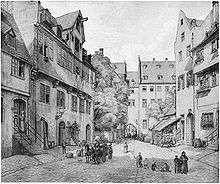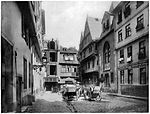Arnsburger Hof (Frankfurt am Main)
The Arnsburger Hof was a business enterprise of the Arnsburg monastery in the old town of Frankfurt am Main . It was built in the first half of the 13th century on a piece of land that had come into the possession of the monastery through donations, and remained a Catholic enclave in the city even after the Reformation in Frankfurt in 1533. In 1803, as a result of secularization , the Arnsburger Hof fell to the city, which used it for various social institutions and as a school building. The municipal high school was located here from 1837 to 1876 .
The Arnsburger Hof burned down in 1944 during the air raids on Frankfurt am Main . The ruins were removed in 1953/54 and Kurt-Schumacher-Straße was built over.
Location and surroundings
The Arnsburger farm lay south of the Predigergasse that the amount of the Garküchenplatzes from the lane branched off. This important north-south connection in the eastern old town led from the Bornheimer Pforte at the Konstablerwache to the Old Bridge . In the southern area of Fahrgasse there were important buildings such as the Fürsteneck house and the flour scales , the Frankfurt guilty prison. Compared to this main street in Frankfurt, Predigergasse was a quiet side street. It was named after the Dominican monastery to the north . On the southern arm of the alley, facing south, separated by a gate building, was the Arnsburger Hof, and on the opposite northern side of the street was the Kompostellhof .
The Arnsburger Hof was lined with several buildings that had been built since the Middle Ages , including the baroque main building built in 1717, the Carthusian courtyard of the Carthusian monastery in Mainz and, since 1616, the vicarage houses , the Fronhof of the Bartholomäusstift . South of the Arnsburger Hof, the Brückhof , located directly on the bridge, was connected .
history
The Cistercian Monastery of Arnsburg , founded in 1174, received a plot of land within the Frankfurt city wall in 1223 through a donation from the Frankfurt citizen Baldemar , which was soon followed by more. The monks set up a farm yard on the site. The municipal property gave the religious the citizenship of Frankfurt and allowed them to participate in the political and economic life of the city. Like other important monasteries, they used their Frankfurt branch to sell their products or to meet their own needs. The Arnsburger Hof also took on administrative tasks for the order, where a room was always kept free for the abbot of the monastery.
The Jacob's Chapel , which was also used by the pilgrims to Santiago de Compostela , belonged to the courtyard . The Compostellhof opposite served them as a hostel on the Way of St. James .
In 1533, at the urging of the citizens, the Frankfurt council banned Holy Mass and thus introduced the Reformation. The branches of the Catholic orders remained untouched, including the Arnsburger Hof. From then on they formed Catholic enclaves in the Free Imperial City, which had become Lutheran .
In 1715 the order had its old buildings demolished and a new building carried out by the Arnsburg Father Bernhard Kirn . At the same time, Kirn also built the Bernusbau in the Saalhof .
During the secularization of 1803, the Arnsburger Hof fell to the city of Frankfurt. In 1837 she set up the municipal high school in the dilapidated buildings , because its original domicile, the former barefoot monastery , had to give way to the new building of the stock exchange on Paulsplatz . The dark monastery rooms were hardly suitable for school operations, especially as the population of Frankfurt increased and therefore the number of pupils also increased. Despite the cramped conditions, the Free City of Frankfurt managed to win over important scholars such as the classical scholars Johannes Classen and Tycho Mommsen and the historians Theodor Creizenach and Johannes Janssen for the grammar school.
In 1876 the city finally relocated the high school to a more suitable location on Junghofstrasse . A municipal elementary school and the administration of the general alms box moved into the Arnsburger Hof . The smaller houses surrounding the courtyard were mostly inhabited by craftsmen, house number 8, a baroque half-timbered house, housed the town's soup establishment.
The Arnsburger Hof was also hit in the air raids in March 1944 . All the houses burned out. The baroque façade facing Predigergasse initially remained in place, but its ruins were removed in 1953/54 because a new north-south axis, Kurt-Schumacher-Strasse , was built across the site from Konstablerwache to the Alte Brücke. Today nothing in the cityscape reminds of the Arnsburger Hof.
literature
- Frankfurt Historical Commission (ed.): Frankfurt am Main - The history of the city in nine contributions. (= Publications of the Frankfurt Historical Commission . Volume XVII ). Jan Thorbecke, Sigmaringen 1991, ISBN 3-7995-4158-6 .
- Fried Lübbecke : The face of the city. Based on Frankfurt plans by Faber, Merian and Delkeskamp 1552–1864 , Frankfurt am Main 1983, Waldemar Kramer Verlag, ISBN 3-7829-0276-9
Coordinates: 50 ° 6 ′ 38.1 ″ N , 8 ° 41 ′ 16.9 ″ E



